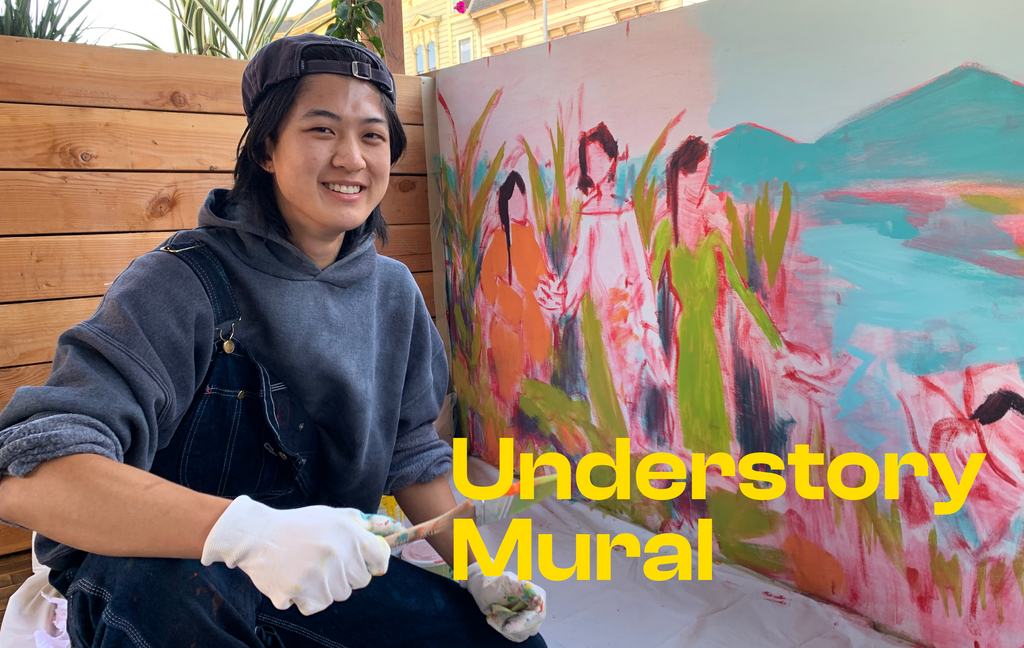Parklet Mural at Understory

We are so excited to unveil our latest community-funded project, a parklet mural by artist Cairo Mo at Understory and Oakland Bloom. This was such a fun collaborative project!
Oakland Bloom is a nonprofit that works towards developing new cooperative food business models that prioritize community, people power, and economic equity for poor and working class immigrant, refugee, and PoC chefs.
Understory is a POC worker-led restaurant, bar, and commissary kitchen in Oakland that works closely with Oakland Bloom.
We hired AAPI artist and Persimmon Resident Cairo Mo to create a mural that visually represents Understory and Oakland Bloom values.





Cairo says of the mural:
Just seven generations ago, the place I reside in looked much differently than it does now. I imagine the chaparral landscape was forested and abundant, full of plant foods and medicines, pollinators, and four legged animals and birds and fish. Oak trees ripe with acorns, streams flush with trout, and brambles of blackberries.
Beginning with the ongoing violent settling of this area, the subsequent industrialisation and urbanisation disrupted this mutual process of give and take between the people and the land. The disconnect between us and our food grew until it became our current agriculture system -- large scale, intensive production that removes us from where our food is cultivated, who grows it, who brings it to us and prepares it.
As the child of immigrants to the Bay, I am not Muwekma Ohlone although I live and work on their land. I actually have no ancestral land, since my mother and her family are descendants of the Hakka people (literally “guest family”), a nomadic group of Southern China.
And still the land has taken care of me. My privileges and luxuries are only possible because of the ocean, the rivers, plant-life, humans and more-than-human beings that are inextricably part of this place. Like any good inhabitant, I have a duty to reciprocate the gifts that I have received.
Part of this process for me is working to revitalise urban ecosystems. After WWOOFing in the Hudson River Valley, attempting to get my Master’s in sustainable agriculture, and apprenticing with Black Earth Farms, I feel hopeful about continuing on this path. Currently, I am excited to contribute towards a revitalisation of Garrity Creek.
Until now, I was not clear on how my art practice fit into this work, the two pursuits that pulled me in different directions. When Understory and Oakland Bloom told me about what they wanted to see in a mural, my paths finally aligned.
I am still trying to figure out my place here, but I like where I am now.
The themes that Understory and Oakland Bloom gave me for the mural included:
- Internationalism and solidarity (Third World Liberation)
- Land
- Worker rights
- Bright and bold
- Logos for understory / OB
- Celebration of Food
- Foods you may not see in a mainstream grocery - heritage plants and veggies
- Principles and values represented as images e.g. people sharing food
- Bold statement and words, written out
- Multilingual?
- Nod to Oakland
My response to this prompt is a story told through 5 scenes, each on its own panel, connected through time and space. It is a celebration of food, from the land and her stewards, to the people who cook it, and the community that shares it.
The three sisters of a Native American story (squash, corn, and beans) pass on heirloom seeds. The bean sister hands seed pods as beans to farm workers in SE Asia/the Philippines, who are tending rice paddies as the sun rises over the mountains.
The story of the three sisters teaches us about how to plant their seeds. Robin Wall Kimmerer retells the legend in her book, Braiding Sweetgrass. Corn is planted first, to grow into a tall stalk. Then, bean is planted, giving nitrogen to the soil and climbing on the corn. Last, squash is planted, and its wide leaves cover the ground and keep moisture in the soil.
“Native people speak of this gardening style as the Three Sisters. There are many stories of how they came to be, but they all share the understanding of these plants as women, sisters. Some stories tell of a long winter when the people were dropping from hunger. Three beautiful women came to their dwellings on a snowy night. One was a tall woman dressed all in yellow, with long flowing hair. The second wore green, and the third was robed in orange. The three came inside to shelter by the fire.”
The rice paddies transition into lettuce fields. Gathered in a circle are Filipino and Chicano farm workers. They are organising for the UFW, a union created during the farm labour rights movement.
The farm workers mobilise and march off into the distance. They join forces with others and come together in a formation. The people cross the chaparral Californian landscape, following a river as it flows into a creek under the bridge.
As the people march on, they hold a banner for labour and land justice. Chefs wearing oakland bloom and understory aprons are cooking and serving food to the protesters. The food is a dish of pumpkin, beans, and corn.
Day transitions into night and the landscape becomes the intersection of 14th and Broadway. During the Fuck the Curfew action, protesters gather in the streets to dance and share food with each other.
